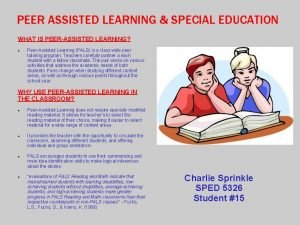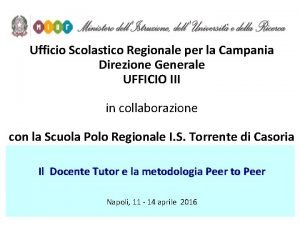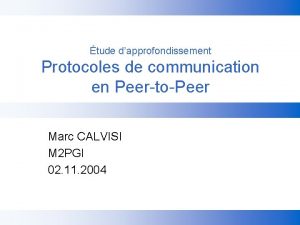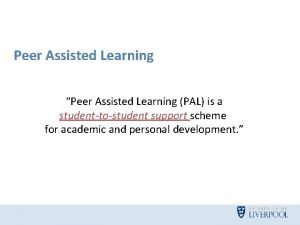PEER ASSISTED LEARNING SPECIAL EDUCATION WHAT IS PEERASSISTED


- Slides: 2

PEER ASSISTED LEARNING & SPECIAL EDUCATION WHAT IS PEER-ASSISTED LEARNING? Peer-Assisted Learning (PALS) is a class wide peer tutoring program. Teachers carefully partner a each student with a fellow classmate. The pair works on various activities that address the academic needs of both students. Pairs change when studying different content areas, as well as through various points throughout the school year. WHY USE PEER-ASSISTED LEARNING IN THE CLASSROOM? Peer-Assisted Learning does not require specially modified reading material. It allows for teacher’s to select the reading material of their choice, making it easier to select material for a wide range of content areas. It provides the teacher with the opportunity to circulate the classroom, observing different students, and offering individual and group assistance. PALS encourages students to use their summarizing and main idea identification skills to make logical inferences about the stories “evaluations of PALS Reading and Math indicate that mainstreamed students with learning disabilities, lowachieving students without disabilities, average-achieving students, and high-achieving students make greater progress in PALS Reading and Math classrooms than their respective counterparts in non-PALS classes” - Fuchs, L. S. , Fuchs, D. , & Karns, K. (1999) Charlie Sprinkle SPED 5326 Student #15

HOW TO USE PEER ASSISTED LEARNING FOR READING WHO CAN BENEFIT FROM PEER ASSISTED LEARNING English Language Learners Learning Disabled Communication/Speech Disorders Gifted/Talented SPECIAL EDUCATION BENEFITS ASSOCIATED WITH PALS • • • Actively involves all students in tasks they can perform successfully. Increases student opportunity to read and practice basic math skills. Motivates students to do better in reading and math. Expands instructional resources in the classroom. Provides for positive and productive peer interaction. Creates opportunity for lower functioning students to assume an integral role in a valued activity. Allows students with disabilities to spend more time in least restrictive environment and increases their access to the general education curriculum. Helps teachers accommodate academic diversity. Accelerates student achievement in reading and math. Is affordable and easily implemented. Is found to be an enjoyable activity by teachers and students. • Decide with content area or subject you want to cover and pick a reading exercise which accompanies it. • Pair students based on skill levels and social compatibility. • In each pair, one student serves as the COACH while the other is the PLAYER. • Teachers make pairings by ranking every student on reading capabilities and splitting the list in half. The teacher then pair the two most capable students from each list, the second two most capable, and so on. • Pairs are changed frequently so that each student eventually has the opportunity to be both a coach and a player. • PALS reading activities include partner reading with retell, paragraph summary, and prediction relay. Partner reading with retell requires coaches and players to read out loud to one another in order to increase oral reading fluency. • As one student reads, the other assists the student with word recognition errors. Paragraph summary fosters summarizing and main idea identification skills. • The intervention is typically implemented two to four times per week for 25 to 35 minutes a session, but schedules may vary based on subject matter and grade level. Sources: Fuchs, L. S. , Fuchs, D. , & Kazdan, S. (1999). Effects of peer-assisted learning strategies on high school students with serious reading problems. Remedial & Special Education, 20(5), 309 -318. Iyer, D. i. (2011). Considering Peer Associated Learning Methods in New Zealand’s Special Needs Education Sector. Journal of Special Education & Rehabilitation, 12(3/4), 91 -101. doi: 10. 2478/v 10215011 -0014 -6 Rafdal, B. H. , Mc. Master, K. L. , Mc. Connell, S. R. , Fuchs, D. , & Fuchs, L. S. (2011). The Effectiveness of Kindergarten Peer-Assisted Learning Strategies for Students With Disabilities. Exceptional Children, 77(3), 299 -316.



